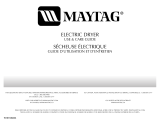
13
■ Were items soiled when placed in the dryer?
Items should be clean before being dried.
■ Were items properly sorted?
Sort light colors from dark colors. Sort colorfast items from
noncolorfast items.
Items shrinking
■ Was the dryer overloaded?
Dry smaller loads that can tumble freely.
■ Did the load overdry?
Check the manufacturer’s care label. Match dryer setting to
load type. See “Drying, Cycle, and Temperature Tips.”
Loads are wrinkled
■ Was the load removed from dryer at the end of the cycle?
■ Was the dryer overloaded?
Dry smaller loads that can tumble freely.
■ Did the load overdry?
Check the manufacturer’s care label. Match dryer setting to
load type. See “Drying, Cycle, and Temperature Tips.”
Odors
■ Have you recently been painting, staining, or varnishing in
the area where your dryer is located?
If so, ventilate the area. When the odors or fumes are gone
from the area, rewash and dry the clothing.
■ Is the dryer being used for the first time?
The new electric heating element may have an odor. The odor
will be gone after the first cycle.
Garment damage
■ Check the following:
Were zippers, snaps, and hooks left open?
Were strings and sashes tied to prevent tangling?
Were care label instructions followed?
Were items damaged before drying?
ASSISTANCE OR SERVICE
Before calling for assistance or service, please check
“Troubleshooting.” It may save you the cost of a service call. If
you still need help, follow the instructions below.
When calling, please know the purchase date and the complete
model and serial number of your appliance. This information will
help us to better respond to your request.
If you need replacement parts
If you need to order replacement parts, we recommend that you
only use FSP
®
factory specified parts. These parts will fit right
and work right because they are made with the same precision
used to build every new WHIRLPOOL
®
appliance. To locate
factory specified replacement parts in your area, call our
Customer Interaction Center (in the U.S.A.) or your nearest
designated service center.
In the U.S.A.
Call the Whirlpool Customer Interaction Center
toll free: 1-800-253-1301.
Our consultants provide assistance with:
■ Features and specifications on our full line of appliances.
■ Installation information.
■ Use and maintenance procedures.
■ Accessory and repair parts sales.
■ Specialized customer assistance (Spanish speaking, hearing
impaired, limited vision, etc.).
■ Referrals to local dealers, repair parts distributors, and
service companies. Whirlpool designated service technicians
are trained to fulfill the product warranty and provide after-
warranty service, anywhere in the United States.
To locate the Whirlpool designated service company in your
area, you can also look in your telephone directory Yellow
Pages.
For further assistance
If you need further assistance, you can write to Whirlpool
Corporation with any questions or concerns at:
Whirlpool Corporation
Customer Interaction Center
553 Benson Road
Benton Harbor, MI 49022-2692
Please include a daytime phone number in your correspondence.
Accessories U.S.A.
To order accessories, call the Whirlpool Customer Interaction
Center toll free at 1-800-442-9991 and follow the menu prompts.
Or visit our website at www.whirlpool.com.
In Canada
Call the Whirlpool Canada Inc. Customer Interaction Center toll
free: 1-800-461-5681 Monday to Friday 8:00 a.m. - 6:00 p.m.
(EST). Saturday 8:30 a.m. - 4:30 p.m. (EST).
Our consultants provide assistance with:
■ Features and specifications on our full line of appliances.
■ Referrals to local dealers.
For service in Canada
Call 1-800-807-6777. Whirlpool Canada Inc. designated service
technicians are trained to fulfill the product warranty and provide
after-warranty service, anywhere in Canada.
For further assistance
If you need further assistance, you can write to Whirlpool Canada
Inc. with any questions or concerns at:
Customer Interaction Center
Whirlpool Canada Inc.
1901 Minnesota Court
Mississauga, Ontario L5N 3A7
Please include a daytime phone number in your correspondence.




















